Chapter XII
The Victor Operations
As soon as the Sixth Army was well established in Luzon, the Eighth Army under General Eichelberger was launched on the so called Victor series of operations, the aim of which was to mop up the major islands bordering the Visavan Sea in the heart of the Philippines. Some of these islands were known to have been held very strongly by the japs. We were able to obtain considerable information as to the Jap troop disposition and installations from Filipino guerillas, but, of course, there were certain areas in which no Filipinos were allowed. These areas might be heavily mined and, in fact, some were.
These Victor operations were to consist of major landings on Palawan, Panay, Mindanao and Cebu, but with many lesser landings on neighboring islands. These were exactly the type of operations for which the Brigade had been designed. If we had not already justified our existence in the New Guinea operations, we certainly did in accomplishing all of them all successfully in the Philippine operations.
The first one of the Victor operations was assigned to the 532d Regiment. The objective was the liberation of Palawan, an island of the Philippine group in the Sulu Sea, less than one hundred miles north of British North Borneo. Palawan is no small island; it stretches out over 200 miles. The interior is very mountainous and is fringed by coral reefs like New Guinea rather than with open beaches as at Leyte.
A provisional battalion task group consisting of Company A and Company F, with a medical detachment from the 532d Regiment and a boat maintenance detachment from the 562d Engineer Boat Maintenance Battalion, was detailed for the operation under the command of Major Michael J. Reichet of San Jose, California. The 41st Division, whom we were to support, were old friends of ours and brought back memories of Nassau Bay, Holland, and other historic spots. Prior to embarkation Captain Francis X. Popper of Chicago, Illinois, attached to us from the Coast and Geodetic Survey, made an aerial reconnaissance of the proposed landing site and a small reconnaissance party under the command of Captain Bernard R. Huetter Jr. of San Francisco, California, surveyed the beaches and the adjacent shore in preparation for the operation.
In the mid-morning of 28 February the landing was made without enemy opposition on three beaches near Puerto Princesa, Palawan. General Heavey observed the landing from the air with General Eichelberger, Eighth Army Commander, in the latter's B-17. Colonel Neilson, who had accompanied the Task Force as an observer, Major Reichel and other members of the shore party actually reached and entered the town of Puerto Princesa before the combat troops arrived. When the infantry arrived, a welcoming committee of Amphibs greeted them.
Within a short time the 532d Task Group had the beach and port in operation and supplies were moving into the base in quick order. In the town our engineers also cleaned up the wreckage which had been caused by our air bombings preliminary to the landing.
In spite of the poor weather often prevailing and. frequent rough seas, various minor boat missions were run to different places on the island. Due to heavy seas on a 200-mile round trip to Sir John Brooks Point on 14 March, one LCM being towed by an LSM was lost. Seven days later another LCM was lost in the same way while enroute to Ulugan Bay. Luckily no men were lost on either occasion.
The mission to Ulugan Bay was a 500-mile round trip, all of it being made in the open waters of the Sulu and South China seas. This was the longest open water trip made by our craft in Philippine waters and is worthy of mention because our boats ran into the highest seas and winds they had ever encountered. The fact that we lost only one boat and no lives at all speaks well for the work of our boatmen and the naval vessels conveying us.
The 532d group at Palawan was called upon to support a landing of the 186th Infantry on Busuanga, a small island northeast of Palawan. The 532d group was somewhat different than usual in that it used no landing craft but only DUKWS, carried to the Far Shore in LSTS. The loaded DUKWs were launched at sea down the LST ramps. The landing was made without any unusual incident on 9 April. The DUKWs were used for patrol purposes both in the waters along the shore and inland. On 17 April the US forces left the island after destroying all Jap resistance.
The Palawan operation was neither difficult nor dangerous, but it was vital to control of the South China Sea The Regimental Task Force furnished the same supervision, functions and operations that it had executed on Mindoro. In addition to supervision of all port activity, the 532d Shore Unit erected beach installations, cleared dump sites, constructed or improved roads and made certain necessary clearances in the town proper. In due course Puerto Princesa became quite an air base for local, tactical, patrol and observation missions. From there, planes bombed Borneo and China.
OTHER VISAYAN OPERATIONS
The rest of the Visayan campaign was handled by the 542d Engineer Boat and Shore Regiment. 'Ihis regiment, under Colonel B. C. Fowlkes Jr., had made the hot landings at Wakde and Biak in mid-1944. There it underwent many enemy strafing and bombing attacks. Several months of routine duties followed the overcoming of the Japs. They built a model camp on the coral-cliffed and reef-fringed island of Biak where the regiment had made its hardest combat landing. The men got a well-earned break and time to recuperate and rehabilitate. A lucky few even got furloughs to Australia.
We have already read that Company A of the 542d had moved to the Philippines, moving with 50 LCMs in Navy LSDs from Hollandia to Leyte. Beginning in December 1944 the balance of the regiment moved unit by unit, by water and by air, to assemble at Leyte. Some entire boat crews were flown from Biak to Leyte to man new LCMs delivered at Leyte direct from the States. Others made-the long trip from Milne Bay at the tip of British New Guinea to Hollandia in LCMs assembled at the boat plant. There they were deck-loaded on Liberty Ships or embarked in Navy LSDs for the 1200 mile trip on to Leyte.
Ahead of the regiment lay the Visayan campaign, the recapture of the central islands of the Philippines--Cebu with the second largest city of the commonwealth, Negros, Panay, Bohol, and a flanking assault on the northern coast of Mindanao.
But before even the planning phases of the Visayan campaign began, the 542d plunged into the task of operating the Red and White landing beaches near Tacloban, on Leyte, where thousands of tons of supplies and thousands of men poured over the beach to support the fighting against the Japs making their last stand in the Ormoc corridor on the western side of Leyte.
Taking over gradually from elements of the 532d and 592d, the 542d's Shore Battalion operated discharge and loading facilities on the two beaches. While the Boat Battalion discharged ships in the stream and ran resupply, patrol, and reconnaissance missions for the infantry and guerrillas on Samar and smaller islands in the approaches to Leyte.
In January came the regiment's first action against the Japanese in the Philippines when three LCMs of Company A were assigned to the 381st Infantry for patrol and reconnaissance on the southern coast of Samar island. These LCMS, on the morning of January 27, 1945, stood off St. Margharita village and shelled concentrations of Japanese troops there with 37-mm cannon and mortars mounted in the landing craft. Later reports from guerillas and air observers stated the bombardment accounted for approximately 240 of the enemy; 180 killed and 60 wounded. Our casualties were none.
Company A boatmen swung into the tactical picture in greater strength when on February 18, fifteen LCMs took aboard a reinforced battalion of the Americal Division, veterans of the Solomons, for a combat assault mission against Japanese installations on the northwest coast of Samar and the islands of Capul and Biri, which controlled a part of the vital San Bernardino strait, the main shipping route leading north to Luzon,
On the 19th of February the mission to land on Capul island left the LCM convoy and hit the shore at Capul village after an air attack by four Corsairs. A very bad beach, filled with coral heads, awaited the landing craft, but enemy opposition was light with some knee mortars and small arms fire coming from Japanese on the right flank of the beach.
Meanwhile the rest of the convoy proceeded to the town of Allen, on the Samar coast above Capul, and landed there without opposition to find a ghost town in which no one had lived since 1942 when its inhabitants had fled the threat of Japanese occupation.
From Allen on the 20th of February, 1st Lt Reuben F. Thomas, the mission leader, of Little Rock, Arkansas, and Staff Sergeant Ralph W. Chambers of Pennsville, New Jersey, first wave leader, loaded their five LCMs with Company C, 182d Infantry, for the landing on Biri island, an assault which proved to be as bitterly contested in its few brief minutes as the bloody landing at Wakde island, Dutch New Guinea, which won Company A of the 542d the Presidential Citation as a Distinguished Unit.
At 07:45 four navy Corsairs swept in over the Biri beachhead to strafe and bomb, and four PT boats slid into position through the quiet morning waters spouting fire from their 40 and 20-mm cannon. Between the flanking PT's Sergeant Chambers' two LCMs of the first wave ploughed toward shore, both heavily loaded with infantrymen. Suddenly when the two craft were about 700 yards from the beach a withering blast of machine gun fire came from hidden Japanese positions on the beach. Mortar shells began dropping around the two landing barges.
PFC Harry Pomeroy of Toms River, New Jersey, a machine gunner of Sgt Chamber's LCM, jumped to his gun and returned the fire. Suddenly an enemy machine gun burst swept across the deck and Pomeroy stopped firing for a moment and doubled up as if he were hit around the legs, but immediately resumed his fire. Another burst, and Pomeroy fell still firing the gun. Sgt Chambers, although wounded himself, took over the LCMs 50-caliber and continued firing until the gun was put out of action. Pomeroy had been mortally wounded.
Meanwhile the other LCM was also in serious trouble. Just before his craft hit the beach, T/4 Franklin D. Mackie of Brooklyn, New York, coxswain, was badly wounded and knocked out temporarily. His craft swung broadside to the beach before Mackie could regain control. Pvt Thomas E. Gunning Jr. of Spokane, Washington, seaman, was forward to operate the dogs which allow the ramp to drop when Mackie was hit. Gunning ran aft to help him, and as he crawled out of the well, was hit by Jap fire and knocked back down in the cargo hold. Gunning climbed up and again was struck by enemy fire and fell to the bottom. The third try brought Gunning to the top, where he aided Mackie in retracting the craft, and then relieved the coxswain who was incapacitated by his wounds.
Sgt Chambers' boat had also hit the beach, but the ramp cables had been shot away, so he retracted and both LCMs withdrew out of range to reform and dispose of casualties. In Sgt Chambers' boat the entire crew had been wounded and his gunner, PFC Pomeroy, died of wounds. One infantryman had been killed and twenty-three wounded. In T/4 Mackie's craft, one crew man was wounded as was one infantryman. The mission, after transferring casualties and reforming, decided to outflank the enemy positions, and shortly afterward, landed the infantry on the other side of Biri island without opposition.
Meanwhile at the 542 Regimental Headquarters on Leyte came the order to prepare for participation in the V-1 operation with the occupation and liberation of Panay and Negros islands as the major objective. To land regiments of the 40th Division and support them in re-supply and flanking operations was set as the task for the 542d's combat Team 111, which had last functioned as a separate task force unit in the early days at Tambu Bay Morobe in British New Guinea. Making up 542d's Combat Team III were C and D companies with attached medical and boat maintenance personnel from the 262d Medical Battalion and the 562d Boat Maintenance Battalion respectively. Lt Col Philip W. Long, executive officer of the regiment, assumed command of the combat team and duties as shore party commander in the coming operation, with Major Robert E. Wells of Greenville, South Carolina, as his executive officer.
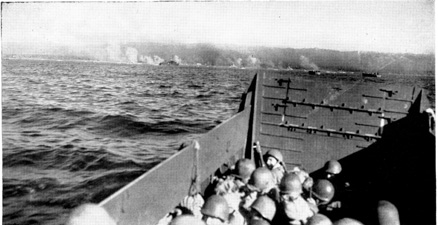
Cebu, Philippine Islands. 26 March 1945. View from landing craft of
Navy bombardment of beach. LCVP of Co. B, 542 EBSR, carrying
assault troops to Green Beach.
With little time for planning Lt. Col. Long on March 4 flew to 40th Division headquarters at Luzon, and Major Wells took command of final details and loading out of the combat team from Leyte. Four days later all loading was completed and Company C's LCMs were ready for the trip to Mindoro where the 542d combat team convoy would rendezvous with the convoy carrying the 40th Division troops from Luzon. A howling rain and wind storm battered the 542d troops in their own LCMs on the 200-mile trip from Leyte to Mindoro, the tough seas delaying the convoy so that it arrived 24 hours late. Fortunately there was a two-day leeway in case the convoy was delayed. Several days of reorganization and reshuffling of vehicles aboard the various LSTs in the Navy convoy followed. Soon all was ready and on 17 March the 542d convoy sailed from Mindoro to meet the main convoy from Luzon at a point fifty miles offshore .and then turned southward toward Panay.
Early G-Day morning, March 18, the forty-ship convoy lay off the beach at Tigbauan, some fifteen miles below the Panay capital city of Iloilo. A brief naval bombardment by accompanying cruisers and destroyers paved the way for the landing on Red Beach at 0900, a landing which encountered no opposition at the beach. As the infantry advanced, Japs were contacted and a small Jap outpost was quickly reduced inland on the road to Iloilo. As the infantry moved toward the capital, 542d reconnaissance showed that Red beach was unsuitable for the beaching of larger landing craft such as LSTS, so Shore Party Headquarters and facilities were moved within a few hours to Blue beach, just across the Sibalon river which constituted the right flank of the Red Beach.
Working under good conditions with favorable terrain hindered only by a shallow beach from which ramps had to be dozed out to the LSTS, all landing craft were completely unloaded by the next morning. The following day all beach organization was functioning smoothly, the infantry had entered the city of Iloilo, which had been abandoned by the enemy, and the schedule was cleared for planning and staging the next phase of the V-1 operation, the seizure of the neighboring island of Negros. The entire shore party organization moved off the initial beachhead and set up operations in Iloilo itself as soon as it had been captured. Preliminary reconnaissance of the Negros landing beaches was started.
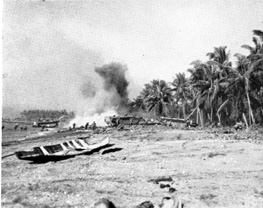 Cebu, Philippine Islands. 26 March 1945. View of beach and infantry under enemy fire. In background is exploding enemyh mine and some of the “Buffaloes” disabled by similar mines. Cebu, Philippine Islands. 26 March 1945. View of beach and infantry under enemy fire. In background is exploding enemyh mine and some of the “Buffaloes” disabled by similar mines.
Escorted by two PT boats, control and support craft of Company C made the three-hour run across Guimaras strait to Pulupandan, projected site for the Negros landing. Soundings were made off the beach, and as no enemy activity was noted ashore, a Navy scout party was landed in a rubber boat. After completing their beach check, the scout party was notified by civilian sources that a small Jap garrison nearby had been alerted. The party then quit the beach area, its mission accomplished without incident. Later information from a prisoner captured after the landing had been made revealed that the Japanese garrison had observed our beach reconnaissance with field glasses, but had made no move to engage the amphibious party.
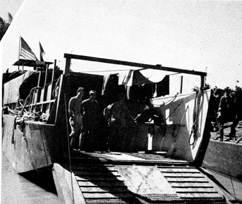 Cebu, Philippine Islands. 26 March ‘45. Hospital LCM of 542 EBSR evacuates casualties from the beach. Cebu, Philippine Islands. 26 March ‘45. Hospital LCM of 542 EBSR evacuates casualties from the beach.
March 29 was Y-Day for the Negros landing, with all the LCMs of Company C making the journey to the far shore under their own power. At H minus three and a half hours Lt Col Harry F. Garber of Quarry, Virginia, Regimental Navigator, with a picket boat, flak and rocket LCMs and two LCMs landed a reinforced platoon of the 185th Infantry on the right flank of the Negros beachhead to secure the bridge over the Bago River. After a brief fire fight the bridge was secured, and at H-Hour the main landing began without opposition from the Japanese.
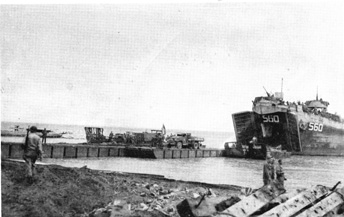
Cebu, Philippine Islands. 26 March 1945. Ponton causeways used by 542 EBSR Shore Engineers to unload LSTs.
The beach itself proved to be narrow and so soft that vehicles bogged down, but within a few hours dumps were established between the streets of Pulupandan, which was immediately behind the beachhead, and an evacuation station was operating in the town plaza, and Shore Party headquarters was settled in the local theatre. The 542d chalked up another successful landing to its growing record.
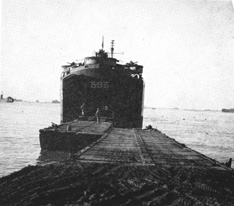 Cebu, Philippine Islands. 26 March 1945. 542 EBSR Shore Engineers use ponton causeway to unload LST. Cebu, Philippine Islands. 26 March 1945. 542 EBSR Shore Engineers use ponton causeway to unload LST.
Development of the Pulupandan area continued during the following days without opposition and regular re-supply shuttles were soon running from Iloilo. Morale was high despite long hours and hard work and Combat Team III settled down in its new home, its major contribution to the Visayan campaign completed.
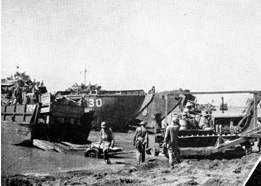
Cebu, Philippine Islands, 26 March 1945.
542nd EBSR Shore Engineers “Cats”
tow equipment onto beach. Equipment
was ferried to shore by LCMs from
LSTs which could not beach; due to shallow water.
Meanwhile at Leyte, the remainder of the regiment, minus Company A which was to remain behind on lighterage work for Base K, was alerted for the V-2 operation which was to encompass the taking of Cebu and surrounding small islands, and landings on the island of Bohol and on the south tip or Negros.
Selected as the Cebu landing site was Talisay Beach, some six miles south of Cebu City and connected with it by an excellent highway. Early intelligence showed that the beach was pillboxed and tank trapped. The possibility of a rough show was anticipated.
March 25 found the Cebu convoy sliding through the Mindanao Sea with the 542d LCMs in tow. Aboard the LSTs were the Amphibian Engineers and two regiments of the Americal division scheduled to liberate the second largest port of the Philippines Cebu City, often referred to as "Little Manila."
Lights shone from the coastal villages of Cebu as the darkened convoy steadily headed through the early hours for the beachhead. Soon after daylight revealed the invasion fleet, the Air Force began heavy bombing of Cebu where enemy naval guns had been reported emplaced. At 07:00 cruisers and destroyers opened up with blasting salvos. Close inshore, destroyers and smaller craft cruised to shatter pin point targets at point blank range while the first waves of amphibian tractors splashed off the ramps of the LSTs and wallowed for the beach.
Sudden spouts of sand and flame as the first Buffaloes crawled into shore warned of a mined beachhead, and the following waves of LCMs and LCVs grounded on the beach to find seventeen of the swimming tractors knocked out by land mines, the wounded already left behind by the infantry advancing inland. Our medical Amphibs immediately went to their rescue and soon had them on the way to hospital LSTs for treatment. Our hospital LCMs did yeoman service in evacuating them quickly to medical aid.
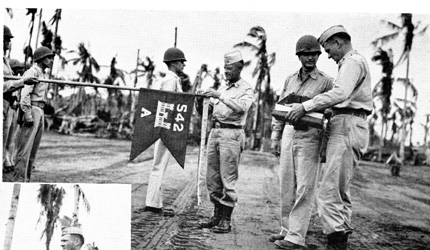
Leyte Philippine Islands, 1945. Brig. Gen. Heavey pinning streamer on Co. A, 542 EBSR guidon in ceremony of the award of the Presidential Citation for Co A action at Wakde Island, Dutch New Giinea.
Warily at first and then with growing speed as they discovered the Japanese mine pattern, demolition crews from Companies E and F of the 542d began sweeping the dune line behind the beach to clear the mines and barriers left behind by the withdrawing japs. Even regimental clerks turned to uprooting mines. Occasional mortar and sniper fire kept coming over the beach but casualties for the Amphibian Engineers were light in spite of the ticklish business in which they were engaged.
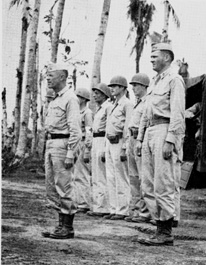
Leyte, Philippines. 12 March 1945. Gen. Heavey with Aide;, Lt. Williams at ceremony to present Presidential Citation to Co. A, 542 EBSR. Cocoanut trees in background cut by artillery fire on day of landing.
Road blocks and mines were cleared from the lateral road behind the beach as the mechanized equipment of the Americal Division began coming ashore across a badly shallowed beach. By afternoon the beach was well organized, and the infantry was pressing on the outskirts of Cebu City after brief firefights along the way. The beach was so shallow it was necessary to install pontoon causeways. LSTs were being nosed into the pontoon ramps when suddenly the submarine alert sounded. Torpedoes had been fired at the vessels standing off the beach. The beached vessels immediately began to retract with the exception of two, which could not pull loose, and the convoy stood out to sea to spend the night.
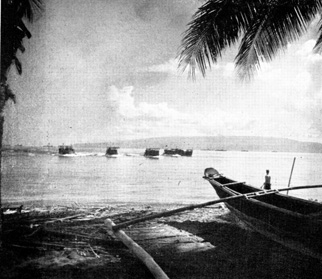
Dumaguete, Negros, Philippine Islands, 25 April 1945. The second wave of LCMs of Co. B, 542 EBSR; bearing personnel and equipment of the American Division to the beach.
Shortly after sunset a plane was heard overhead, the noise growing to a roar as a lone Nip dived on the LSTs left on the beach. With a near perfect target the enemy plane loosed a single bomb which struck the water just between the two LSTS, spraying several of our LCMs cruising about, but causing no casualties nor damage. No more planes appeared - the total effort of the Japanese Air Force in the central Philippines had been expended. Our Air Force had really crippled the Jap Air Force in the Philippines. What a difference from the Jap air power in the early days of Lae and Finschhafen and even as late as Biak.
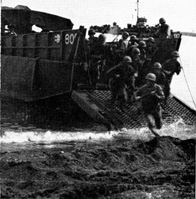 Macajalar Bay, Mindanao, Philippine Islands, 10 May 1945. The landing of the two millionth passenger carriedd in 2 ESB boats. Infantrymen coming off LCM of Co. B, 542 EBSR. coxwained by Sgt. Frank J. Koenig. Macajalar Bay, Mindanao, Philippine Islands, 10 May 1945. The landing of the two millionth passenger carriedd in 2 ESB boats. Infantrymen coming off LCM of Co. B, 542 EBSR. coxwained by Sgt. Frank J. Koenig.
Two days later, after unopposed landings on Cauit and Mactan Islands guarding the Cebu harbor and approaches, the 542d moved into the city and set up headquarters in the badly shelled Customs House. It was the first time it had occupied a real building since leaving Fort Ord in February, 1943. The city was deserted, a mass of shattered buildings, bomb pocked streets, snarled road blocks and naval demolitions which the japs had left behind in their retreat to the heights overlooking the city where bitter holding action was being fought. The Boat Battalion was established on nearby Gauit Island after the Support Battery had plastered the island with rockets. This island turned out to be one of the best homes the 542 Boat Battalion ever had. It was usually swept by cool winds and its sandy soil absorbed the heavy rain fall when it came.
The next day two Liberty ships nosed alongside the city's seawall, the first American vessels to enter the harbor since 1942. Discharge of the ships was started immediately by the 542d, with Colonel Benjamin Fowlkes Jr., the Regimental Commander, in charge of all port operations for the task force. Filipinos acted as stevedores.
Only a few blocks from the Libertys, which were working at night with lights blazing, the division artillery thundered in its continual pounding of the Jap positions less than a mile away. Machine gun fire echoed down from the hills, tracers streaked through the night. During the day heavy and medium bombers and Army and Navy fighters droned through the air in attacks on the Japs in caves in the high hills back of the city.
Shortly after dawn on D/5 the Customs House trembled to the crack of a high explosive shell which burst just beyond the nearby Libertys in the channel. The Japs had opened fire on the cargo ships which were in such tantalizing view of their batteries on high ground. Some 20 rounds of 75-mm shells whined over the Customs House that morning, but the enemy apparently could not depress their guns sufficiently to register - as all his shots were "overs." Score for the day: no hits, 20 errors.
The Americal Division established an artillery OP on the tower topping the Customs House, and as was expected, the Japs opened up again the next morning. The Customs House banged like a drum as the Liberty Ship moored just behind it let loose with its five inch gun in counter battery fire, probably the first time in the Pacific war that .a merchant vessel had engaged in an artillery duel with enemy land-based field pieces.
Two more mornings of fire and counter-fire followed with air bursts from jap pieces exploding just outside the Customs House second story windows, before the Liberty Ship, division artillery, and dive bombing Corsairs put the Japanese batteries out of action. The sum total of Japanese destruction was nil.
Punctuating the heavy' artillery fire during those active days were occasional bursts from enemy 20-mm guns apparently fired promiscuously into the city. In their bivouac area in front of the Customs House four men of Company F of the Shore Battalion were wounded by fragments but fortunately not seriously.
This proved to be the last effort of the Japanese to interfere with our shipping -and cargo discharge activities at Cebu. The infantry had effectively bottled up the Cebu force in the mountains. It would still take many days and many lives, though, before all these japs were obliterated. They fought with the same desperation as on Leyte and Biak.
Minor flanking and landing missions were carried out in April, a small group from Boat Battalion reconnoitering the beaches at Tagbilaran, the main port of Bohol Island, where elements of the Americal were landed April ii.
Starting on April 17 the Japanese behind Cebu City began a withdrawal from their heavily defended positions to the northern portion of the island. Immediately plans -were made to land Americal troops at Danao, some twenty miles to the north of the city, to intercept and cut off the disorganized and retreating enemy. Twenty LCM's accomplished this mission without incident.
Ten LCMs accompanied the Americal Division landing at Dumaguete, on the southern tip of Negros Island. Here again the Japs ran from the beach and took to the caves in the Mountains. The tactical campaign for the 542d in the central Philippines was finished. Minor brushes with the Japs by the Boat Battalion had included the capture of one Jap officer and four men proceeding to Negros by banca, the interception and destruction of two Japs trying to escape from Bohol by banca and the killing of seven Japs moving by raft to an outlying island from northern Cebu.
On 10 May 1945 Combat Team 11 of the 542d took part in the last of the Victor series of operations, designed to drive the japs from the Visayan Islands and northern Mindanao. Combat Team 11 consisted of Company E, a platoon of Company B, a detachment from Regimental Headquarters and Company B, 262d Medical Battalion. The group was under command of Lt Col E. L. Edwards.
On 3 May, a week before the landing took place, a small group of officers, including Captain Harley M. Chatterton Jr., 542d Intelligence Officer of Brattleboro, Vermont, Major Lane, S-2 of the 108th RCT, and Captain Mortimer A. Clift, Brigade S-2, made a reconnaissance of the beach area. This party left Tanauan airstrip, Leyte, early the morning of the third of May and landed on Macajalar Bay, northern Mindanao, near the barrio of Villaneuve, a few miles from the beach selected for the actual landing. Here contact was made with the local guerillas but, contrary to expectations, it was found they did not hold the area near Bugo, selected for the landing. No reconnaissance of the proposed landing beach was therefore possible, however, the guerillas furnished much information on enemy strength and on the condition of the beach, roads and surrounding area.
The main convoy consisting of LSTS, LSMS, LCIs and three FS boats, carrying the 108th RCT and the shore elements of the 5 ' 42d to2ether with Company B, 262d Medical Battalion, staged from Ormoc, Leyte, on 9 May. The platoon of Company B, 542d, operating 16 LCMS, one flak and one rocket LCM and one Picket Boat with a Naval escort of two PT boats left Cebu City on 9 May and made contact with the main convoy the same afternoon off Bohol Island.
The combined force arrived off the beach at Bugo, Macajalar Bay, at dawn of the loth. Planes bombed the flanks, while destroyers laid a barrage of 5-inch shells directly upon the beach. H-Hour was set back one hour when a torpedo was fired ineffectively by an enemy submarine, but the first wave, consisting of buffaloes from the LSTs struck the beach at 1830. The first of our LCMs landed in the fourth wave fifteen minutes later. Their bulldozers immediately set to work hauling vehicles up the soft beach.
The only opposition consisted of a few ragged volleys of rifle fire which our own infantry halted abruptly. The soft sandy texture of the beach proved to be somewhat of an obstacle, but this was overcome by the use of pierced plank to form tracks up the beach and by much hauling by our bulldozers, which was hampered by a lack of towing chains. However the entire convoy was successfully unloaded before nightfall of the first day and a strong perimeter was set up by our shore personnel reinforced by some of the LVTS.
Company B, 262d Medical Battalion, landed at ten o'clock and had their evacuation station set up an hour later.
To our battle-wise men this was a routine landing. Unloading of later echelons of LSMs and LSTs was continued until 7 June 1945, when we were relieved by the 3rd Brigade. During this period the shore engineers maintained twenty-two vital miles of the Sayre Highway leading to the heart of Mindanao and constructed two bridges.
This operation was noteworthy for the fact that, on the first day, craft of the 542d landed the two millionth soldier to be carried by the Second Engineer Special Brigade in its support of operations, which had taken the Amphibian Engineers from Nassau Bay in British New Guinea, by way of Finschhafen, Saidor, Tanahmerah Bay and Wakde Island in Dutch New Guinea, Biak Island in the Schouten group, to the goal of the Philippines.
|